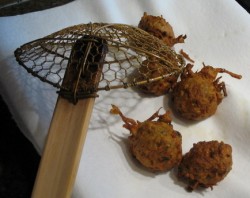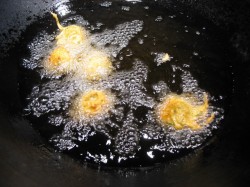Sabz Kofta in Rich Curry Sauce
 Two of my favorite Indian vegetarian dishes are malai kofta and sabz kofta; malai kofta is a vegetable kofta made with cheese mixed with mashed or grated vegetables and bread crumbs, and sabz are kofta made from grated vegetables mixed with garbanzo flour, also known as besan. (Kofta are little balls of meat, cheese or vegetables that are either pan fried or deep fried and are a favorite dish in Northern India.) Since until recently, I always lived near a good Indian restaurant where I could order these dishes often, or eat them from their buffet, I have never bothered to make them at home.
Two of my favorite Indian vegetarian dishes are malai kofta and sabz kofta; malai kofta is a vegetable kofta made with cheese mixed with mashed or grated vegetables and bread crumbs, and sabz are kofta made from grated vegetables mixed with garbanzo flour, also known as besan. (Kofta are little balls of meat, cheese or vegetables that are either pan fried or deep fried and are a favorite dish in Northern India.) Since until recently, I always lived near a good Indian restaurant where I could order these dishes often, or eat them from their buffet, I have never bothered to make them at home.
However, being deprived of my vegetarian kofta after a time is enough to send me to the kitchen. I determined that I liked sabz kofta just a bit better, so I decided to try my hand at them first.
I sought out recipes, and ended up using one from Neelam Batra’s The Indian Vegetarian: Simple Recipes for Today’s Kitchen. At least, I used her recipe for the kofta, while for the sauce, I modified one from Kaushi Bhatia’s Favourite Dishes of India, which is a book that is published in India, for Indians who speak and read English. I have a quite a few books like that, and have found that they tend to be great resources for very good, very authentic recipes that often represent more of the home style cooking of India. The curry sauce recipe I used was one meant to go with malai kofta, which looked like it would taste the way I had eaten sabz kofta at my Pakistani friends’ homes.
I discovered that while the general shape of the sabz kofta recipe was a simple one, the instructions were not clear enough for me to know how to make the dough the correct consistency. Really good sabz kofta are very tender, so much so that they very nearly fall apart when you bite into them, with just the barest crisp to the crust that gives away to a steaming and somewhat crumbly, moist interior. I ended up using too much besan to make the dough stiffer to hold it together, because I was unsure about how much to use, and the description in Batra’s recipe was not specific enough to guide me to make the dough the correct consistency. Also–there are no photographs in her cookbook to guide the sabz kofta novice in getting the texture of the dough correct, so really, unless you have seen them made on television or were taught by the side of a friend or relative, you would be lost reading this recipe.
I want to make this clear–I in no way am dissing Batra’s book or her recipes; I adore the book and used it often when I was learning Indian food, and in fact, this is the first recipe I have ever had come out less than amazing. (I am also sad to see that it has gone out of print.) And it is worth mentioning that even though I thought that the kofta were leaden and somewhat tough, Zak, Morganna and Donny all really enjoyed them, so maybe it was just me. Maybe my expectations were too high. (Or, maybe, the chef at Shere E Punjabi was just great at making sabz kofta–always a possiblity, because his were nearly always light and tender, perfectly spiced and steaming inside.
However, the next time I make these–and there will be a next time, for I really do have a passion for these kofta–I will make certain to not add any extra besan to the dough to make it less soft. (Batra’s words were this–“if the mixture is too soft, add a little extra garbanzo flour.” however, of course, she gives no description of how to determine exactly what “too soft” meant. This is a problem if you have never made these delicious little critters before.)
But, they were fun to make and the sauce was simple as well.The recipe for the kofta made enough that I could serve half the batch and freeze the other batch to be served at a later date. That necessitates that I just make up some sauce some night, thaw the kofta, and toss them in the sauce for a simmer and with some basmati in the rice cooker and maybe some palak paneer–supper is on the table in no time at all.
So, for now, here is my adaptation of Neelam Batra’s recipe for sabz kofta, combined with a slightly revised version of Kaushi Bhatia’s rich curry sauce.

Sabz Kofta in Rich Curry Sauce
Ingredients for Kofta:
1 1/2 cups grated peeled russet potatoes (I used the food processor for all of the grating)
1 cup grated cauliflower
1 cup grated carrot
1 cup grated zucchini
1 cup grated onion
1/2 cup roughly chopped cilantro leaves
1 clove garlic, minced
2 tablespoons peeled and minced ginger
4-8 fresh Thai green bird chiles, minced–to taste
1 1/2-2 cups besan (garbanzo bean flour)
2 tablespoons freshly ground coriander
2 teaspoons freshly ground cumin
1 teaspoon freshly ground pepper
1 teaspoon salt
1/4 teaspoon baking soda
peanut oil for deep frying
Method for Kofta:
Mix together all ingredients down to the chiles in a medium sized bowl. In a separate smaller bowl, mix the rest of the dry ingredients, then sprinkle these over the vegetable ingredients in the first bowl. Knead together into a rough dough. If you think that the dough will not hold together, add a little more besan, but I would say do not add more than about 1/4 cup or so more. (I added more than that, and the texture of the cooked kofta suffered.)
Form into 1 1/2 inch balls–I used a cookie dough scoop and my hands to do this.
Heat oil in a wok or karahi or deep pot, until it is between 350-375 degrees. To test to see if the oil is hot enough drop a tiny bit of the mixture into the oil and if it bubbles and rises to the top, then the oil is ready. Deep fry the koftas, a handful at a time, until they are brown and crispy. Remove with a strainer-basket or a slotted spoon, and allow to drain on paper towels. You can keep them warm in an oven heated to 200 degrees while you make the curry sauce.
Ingredients for Curry Sauce:
2 teaspoons oil
1 medium onion, sliced thinly
1″ cube fresh ginger, peeled and chopped roughly
3 cloves garlic, roughly chopped
1/8 teaspoon cardamom seeds
2 tablespoons coriander seeds
1 1/2 teaspoons black peppercorns
2 1/2 teaspoons cumin seeds
1/4 teaspoon powdered cinnamon
6 whole cloves
1/2 teaspoon turmeric powder
2 tablespoons cashew butter
1 14 ounce can crushed tomatoes
2 cups water
salt to taste
1/2 cup rich yogurt
1/3 cup cream
large handful chopped cilantro
Method for Curry Sauce:
Heat the oil in a heavy bottomed pan–I used enamelled cast iron for this. Cook the onion, stirring, until it is a medium dark reddish brown, and then scrape it out of the pan into the bowl of a grinder or a blender or food processor. Add the ginger, garlic and spices if you are using a grinder like the Sumeet, if you are using a processor or blender, grind the spices with a coffee grinder first, then add them to the bowl of the appliance. Grind into a thick paste.
Reheat pan, pour paste into the pan and stir until well heated and fragrant. Add cashew butter, and stir until combined, then add tomatoes and water. Turn down heat and cook, simmering until the curry sauce thickens to coat the back of a spoon. Whisk the yogurt and cream together, then add to the sauce, stirring to combine. Taste for salt and correct seasoning. (You can prepare the sauce to this point, then hold it warm for about four hours, or cool it and keep it in the fridge until needed–the flavors will only develop and become more complex the longer you allow the curry sauce to sit.)
To the simmering sauce, add in the still warm kofta, and allow to sit, warming in the sauce for at least ten minutes or so.
Serve with plain steamed basmati rice.
11 Comments
RSS feed for comments on this post.
Sorry, the comment form is closed at this time.
Powered by WordPress. Graphics by Zak Kramer.
Design update by Daniel Trout.
Entries and comments feeds.





Wow, Indian Hushpuppies, Cool!
Any sausage in that curry gravy?
🙂
Comment by Bryian — March 1, 2006 #
Yummy!! Thats so tempting Barbara! BTW, the round-up is up, hope you have a look at them! :o)
Comment by Meena — March 1, 2006 #
Barbara,
So, for those of us who just CANNOT bring ourselves to deep-fat-fry anything, is there any hope of making something similar with a *little* bit of oil in a saute pan?
Judy
Comment by judy wyatt — March 1, 2006 #
The texture of well-made sabz kofta are more tender than hushpuppies, Bry–though these were more like hushpuppies. (I love hushpuppies, btw–tasty wee things.) Next time I make them, they will have a nicer texture–maybe I will have you over for some.
Meena–I will stop by! I am excited to see what everyone posted for the event!
BTW–what is the next theme? 😉
Judy, to do them in smaller amounts of oil, I would try this–form them into balls and then flatten them into discs, then pan fry them in a much smaller amount of oil. You must be careful when turning them–they will fall apart easily. I would only turn them once, frankly. Then, proceed with the recipe–keep them warm and then make the curry sauce and add them and simmer for a short time as directed.
If you do this–let me know how it turns out–I am too curious!
Comment by Barbara — March 1, 2006 #
Mmm, I love kofta and have not made the dish in ages. I’ve been wanting to make it for Richard (I prefer paneer koftas). Thanks for the reminder!
Comment by Jenn — March 1, 2006 #
I’ve been looking for a decent recipe for Kofta for a while now.
Thank you! I think I’ll try this recipe this weekend.
Comment by Megan — March 1, 2006 #
Jenn, Megan–let me know how the kofta turn out!
Comment by Barbara — March 1, 2006 #
Barbara,
I have been enjoying your blog for some time. Very very informative.
I made this kofta curry with bottle gourd (lauki) today. I guess Kofta’s can be made with any vegetable. It helps to squeeze the excess water out of the grated vegetables before you add the besan. After making the koftas I realized I should have replaced about one fourth the quanitity of besan with rice flour. This would have made the koftas crispier. This is a common technique in Indian cooking.
For a lighter version of the gravy:
Saute some cumin, cloves, cinnamon and cardomoms in a little oil. Then saute a couple of finely sliced onions and a couple of tomatoes and ginger-garlic paste. Add a tbsp of tomato paste to take the edge off the fresh tomatoes. Add your usual spice powder mixture of curry powder, cumin powder, coriander powder and turmeric powder. Add salt and two to three cups of water and allow to cook for 20 minutes or so. A pressure cooker works great for this as it gives a unique tatse/consistency/texture. When the curry is done add more water if needed and some fresh cream and allow to bubble lightly for a minute or two. Garnish with coriander leaves.
Since you love curries, thought you would like some simple tips from an Indian woman.
Regards, Saahitya
Comment by Saahitya — March 7, 2006 #
Saahitya–thank you for the curry sauce recipe! It sounds wonderful, and I think it will be great when tomatoes are back in season here again. (A time which I long for and await with great anticipation every year!)
I will try your technique of adding rice flour–I think that also may be why the chef at Shere e Punjabi’s kofta were so light and crisp on the outside.
And you are right about squeezing out the water–I have no idea why I didn’t think to do that! I always counsel people when they make spinach or zucchini quiche to squeeze out the excess moisture–so I am not sure why I didn’t think of it. But you are right–that will help the texture immensely.
I am glad you are enjoying my blog–welcome to you, and I hope you jump in and give tips again–you are always welcome! I love sharing ideas with people.
Comment by Barbara — March 7, 2006 #
What food processor did you use for grating the vegs.
Comment by jyoti — November 29, 2006 #
Yum!
Comment by Phil — March 27, 2007 #